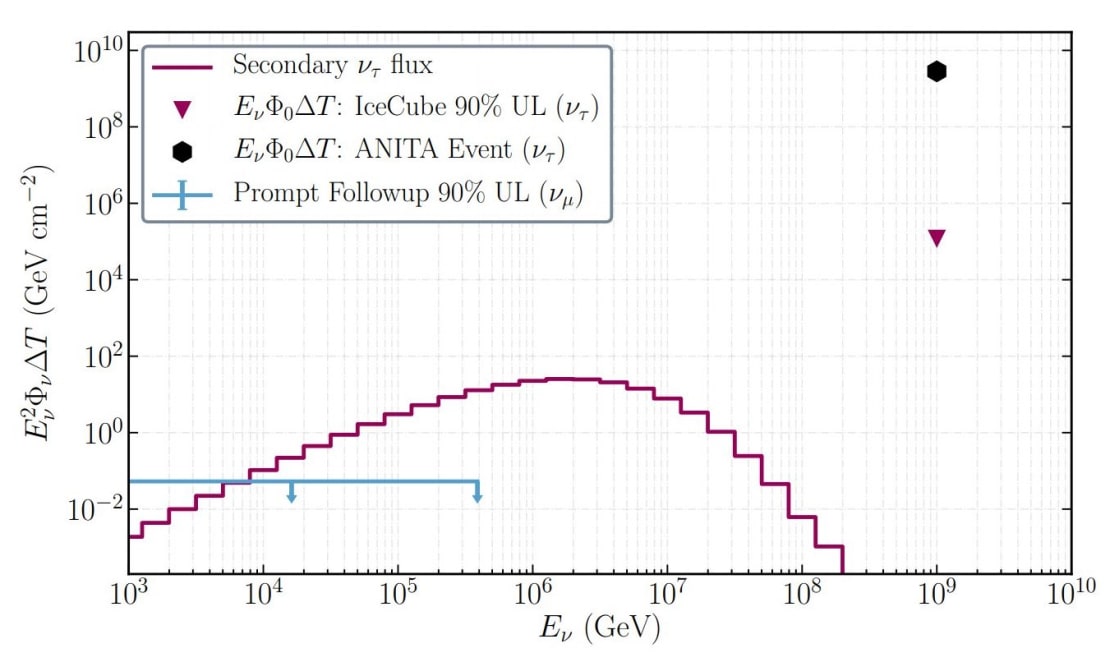The IceCube Neutrino Observatory is possibly the strangest telescope on Earth. From its home at the South Pole, it sits and waits for fundamental particles called neutrinos to pass through its 5,160 optical detectors buried in the ice. When a neutrino interacts with a hydrogen or oxygen atom in the ice, it produces a signal that IceCube can detect.
But IceCube isn’t the only neutrino experiment in Antarctica. There is also the ANITA (the ANtarctic Impulsive Transient Antenna) experiment, which flies a balloon over the continent and points radio antennae toward the ground. ANITA searches for radio waves because extremely high-energy neutrinos—those hundreds of times more energetic than the ones that IceCube commonly detects—can produce intense radio signals when they smash into an atom in the ice.
From its balloon flights, ANITA claimed to have detected a few events that appear to be signals of these extremely high-energy neutrinos, so the IceCube Collaboration decided to investigate. In a paper submitted today to The Astrophysical Journal, they outline their search for an intense neutrino source in the direction of the events detected by ANITA. The collaboration found that these neutrinos could not have come from an intense point source. Other explanations for the anomalous signals—possibly involving exotic physics—need to be considered.

When ANITA reported signals that looked like extremely high-energy neutrinos, physicists were puzzled. These neutrinos had arrived at an angle that suggested they had just traveled through most of the planet, which is not expected for neutrinos at these energies.
“It’s commonly said that neutrinos are ‘elusive’ or ‘ghostly’ particles because of their remarkable ability to pass through material without smashing into something,” says Alex Pizzuto of the University of Wisconsin–Madison, one of the leads on this paper. “But at these incredible energies, neutrinos are like bulls in a china shop—they become much more likely to interact with particles in Earth.”
Many scientists have since come up with potential explanations for these weird signals, and one possibility is that a really intense neutrino source produced them. After all, if a source produced huge numbers of neutrinos, it is more plausible that one or two made it to ANITA.
So Pizzuto and his collaborators decided to see whether there was an intense neutrino source shooting a beam of neutrinos toward Earth—a point source. To do this, the researchers took eight years of IceCube data and looked for correlations between the locations of the ANITA events and the locations of the IceCube events.
Since the researchers could not know how long a potential point source might have been emitting neutrinos, their analyses used three different and complementary approaches equipped to find coincidences on different timescales. Their analyses also had to account for uncertainty in the ANITA events’ directions because the events do not have definite positions on the sky.
Once they had addressed those challenges, the researchers simulated neutrinos passing through Earth to see how many incident neutrinos would be necessary for ANITA to see one event, and they then did the same for IceCube.
In all three searches, they found no evidence for a neutrino source in the direction of the strange ANITA events. This is particularly intriguing because, due to a process called tau neutrino regeneration, the extremely high-energy events that don’t make it all the way to ANITA should still be detectable by IceCube.
“This process makes IceCube a remarkable tool to follow up the ANITA observations, because for each anomalous event that ANITA detects, IceCube should have detected many, many more—which, in these cases, we didn’t,” says Anastasia Barbano of the University of Geneva in Switzerland, another lead on this paper. “That means that we can rule out the idea that these events came from some intense point source, because the odds of ANITA seeing an event and IceCube not seeing anything are so slim.”
When the ANITA events were detected, the main hypotheses were an astrophysical explanation (like an intense neutrino source), a systematics error (like not accounting for something in the detector), or physics beyond the Standard Model. “Our analysis ruled out the only remaining Standard Model astrophysical explanation of the anomalous ANITA events,” says Pizzuto. “So now, if these events are real and not just due to oddities in the detector, then they could be pointing to physics beyond the Standard Model.”
Ibrahim Safa of UW–Madison, another lead on this paper, says that while it has been an exciting time for physicists trying to explain these events, “it looks like we’ll have to wait for the next generation of experiments, which will increase exposure and sensitivity, to get a clear understanding of this anomaly.”
info “A search for IceCube events in the direction of ANITA neutrino candidates,” IceCube Collaboration: M. G. Aartsen et al., The Astrophysical Journal 892 (2020) 1, iopscience.iop.org, arxiv.org/abs/2001.01737